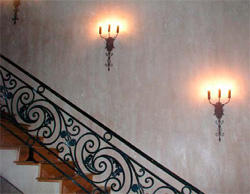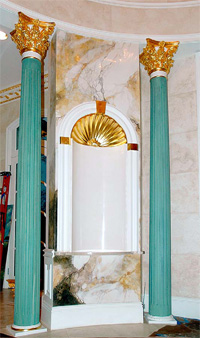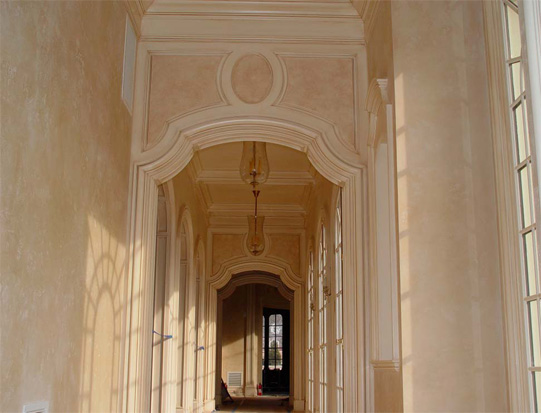To begin, there is no one thing that is "Venetian plaster." It is a term widely used to describe the rich, glowing finishes we associate with that beautiful Italian city, Venice. The term is applied loosely to results achieved with anything from inexpensive thick paint products to costly lime plasters with marble flour.
Most experts prefer to call Venetian plaster a technique or look rather than a product in order to avoid confusion about materials. Venetian plaster is a term that refers to "an integrally colored, smooth paste plaster that is applied in thin layers to achieve a smooth, marble-like finish," says Dean Sickler, owner and founder of Dundean Studios Inc., in Chatham, N.J.
In fact, being clear about naming products and materials used for this technique is critical because its use is growing rapidly in the United States, increasing the occurrence of misunderstanding and misapplication. Artisans in this industry agree that less-expensive paint or cement products should not be confused with true lime or synthetic plasters because the cheaper materials do not deliver the look or longevity of higher-quality products. "There are dozens of products calling themselves 'Venetian plaster,'" explains Victoria Bingham, founder of the Buon Fresco studio and the Academy of Wall Artistry in Falls Church, Va. "I define the product by its application and result, regardless of whether or not lime is present. A high-end Venetian plaster is applied with a steel trowel and burnishes naturally to a very high shine with the same tool prior to any top-coating. A fine plaster sings. Artificial plasters are applied like paint and have the artificial shine of paint if they shine at all."
Sickler expands on this theme. "One can take any inexpensive flat paint or patching material that has a large chalk content, apply it to a flat surface, let it dry and burnish it with a cotton cloth to a shiny surface," he says. "A synthetic plaster/paint formulation with a large chalk content like this will always remain fairly soft … and will wash right off the surface with water. Since chalk is fairly opaque, there is little translucency, and only a small amount of visual texture remains after all the work of applying and burnishing."
Faux plasters are an outgrowth of the faux-paint finish trend, and paint manufacturers have moved into the business to keep their customer base, says Tony Fiocco, managing director of FirmoLux LLC in Sarasota, Fla., a division of the European company Finergy Development. They are often based on paint formulas or portland cement, he says. "These products are available at

home centers and paint stores, often as a loss leader so as not to lose a paint customer."
Paint-like products have their place, says Bill Gauthier of American Burnish in Beacon, N.Y., but that place is definitely not the do-it-yourself market. "The problem is anyone can go to a home center and buy the product and then they want to know, can they brush it on? What's a trowel? What's a blade? Venetian plaster needs to be installed by an artisan installer working for an architect or designer."
To get the depth and richness that typifies the best Venetian plaster, skilled applicators use traditional natural lime materials or carefully formulated man-made synthetic plasters.
Lime plaster, sometimes called Italian plaster, Grassello or Marmorino, is based on limestone (calcium carbonate).
Limestone is baked at high temperatures to extract carbon dioxide and water, leaving calcium oxide in powder form, explains Nurit Regev of TexSton Industries Inc., Canoga Park, Calif. Next, the material is slaked - water is added and unbaked particles filtered out. The mixture is aged for up to a year, resulting in hydrated slaked lime. Pigments, marble flour or minerals are then added.
In addition, acrylic or other resins may be added to improve adhesion to sealed surfaces, such as primed drywall. "Very few to none of the natural decorative plasters being sold commercially in North America are purely natural," Sickler says. "A plaster that has no man-made (synthetic) ingredients in it has to be applied over an absorbent substrate like unsealed stucco, fondo (a specialty primer), plaster or masonry. The market standard for a mineral plaster to be called natural is that it should be at least 95 percent natural ingredients."
Scott Nelson, owner of Naturalwalls in Pasadena, Calif., favors hydraulic lime supplied from Europe by St. Astier that has no resins added to the material. He emphasizes the importance of knowing how to work with lime plaster, especially managing the cure. "You can just put an acrylic up and walk away," he says. "With lime you have to manage the rate of cure after each coat. It has to cure slowly to get strength, so you may have to put a tarp over it so it won't dry out too fast and crack." He recommends waiting 10 days between coats. "This slow set time prevents the cracking that you see with colored cement-based plaster."
As lime plaster cures, it reverts to the same chemical composition as limestone. The resulting finish is extremely durable. "It lasts the life of the building, so there is no need to recoat or repaint after just two or three years," says Regev.
Gauthier believes this durability is an advantage of lime plasters, which he always uses in high-traffic areas. "Lime is the hardest of the two," he says. "Synthetics are softer - easier to gouge and harder to touch up."
He also says lime is thicker, so it hides irregularities. "You can float lime plaster over imperfections. Synthetics go on so much thinner. Razor-thin layers give you the richest color and depth, but imperfections will show through. Synthetics need better wall preparation."
Regev explains other benefits of lime plaster. "The surface remains flexible, which reduces cracking. And it is moisture-permeable, so it breathes."
Nelson has a graphic illustration of this moisture-permeable quality of lime plasters. "We finished a house with lime plaster and washed it with raw oxide pigments just as the plaster was setting up. The house next door was finished with a cement plaster. When it rains you can see the difference. The lime plaster dries out in a few hours but the cement plaster retains the water - it stays dark longer," he says.
Another advantage of natural plaster is mold and mildew resistance. The pH level of lime inhibits mold growth. Nelson believes its permeability also helps prevent mold that might be supported by trapped moisture. "Vapor-permeable is better than waterproof," he says.
Natural plasters are also finding their place in the roster of green building products. Longevity is one factor - less material is used and less waste generated when recoating is less frequent. Also, traditional manufacturing methods are energy-efficient and off-gas little or no toxic chemicals.
Unfortunately, the word "synthetic" has come to be associated with the poor performance of cement-based or paint-like artificial plasters. In contrast, there is a class of engineered synthetic plasters that deliver desirable handling and performance benefits. These are high-end products that deliver a professional look. They are only available to the trade, not to do-it-yourselfers.
Optimizing the formula (think of it as a recipe with the best new ingredients) allows suppliers to bring out certain qualities. Gauthier explains that these synthetics are usually based on a modified latex acrylic binder with marble dust in it. "It takes color beautifully," he says, "and has a smooth, glassy finish because there is no aggregate in it. It can polish to a high shine and a wax makes it even richer."
The cross-linked polymer of a high-end acrylic plaster also imparts a high degree of flexibility to the finished product, according to Brian Pfaff, training and sales manager for the Briste Group International, Oshawa, Ontario, Canada. He says the cured plaster can withstand bending of up to 180 degrees.

Bingham uses some Marmorino and lime-based plasters, but she says she achieves many of her best results with fine synthetic plasters. "They are easier to use. They trowel onto the substrate smoothly and adhere well. Also, there are no time-wasting wet-edge issues. The material doesn't lift up while you work over it."
Gauthier describes the same experience. "With lime plasters you have to be mindful of the wet edge. You have to finish each coat in one pass. You really need two people - one to lay it down and one to follow and close it up - to fill in and compress the material before the water leaves it. With synthetics you can stop halfway and not have an edge."
Bingham believes high-end synthetics offer durability superior to paint-like artificial plasters. An informal survey of her clients showed that applications dating back 10 years to the beginning of her business still look like they were done yesterday, even in humid kitchens and bathrooms.
Finally, Bingham prefers the finished result she achieves when she burnishes a synthetic plaster. "It's like compacting a diamond out of coal. The finished walls are stunning, with depth, shine and exquisite nuance. When I make a marble in plaster it looks like marble. When I stencil a damask design into the plaster, the result is as soft and smooth as fabric. When we make a Venetian plaster tile it shines like porcelain. All from the exact same pot of plaster." She adds that synthetics give her a "razor-sharp" stencil line because they let her start with a mirror-smooth surface.
While Sickler likes the natural color variability of lime plaster, he points out that for customers who want a precise color, synthetics are simpler to match. For example, the Briste Group supplies its SmoothRock Venetian Plaster ST 500 in 38 standard colors. Kolcaustico claims its plaster can be easily tinted using universal tints such as Mixol, up to 10 percent by volume.
Sickler points out that each color gives synthetics both a light and medium value. He believes that a natural lime plaster is required to get a dark color value. Bingham is working with an Italian manufacturer of synthetic plaster to develop a formulation with a neutral base so that darker values can be obtained more easily.
Gauthier likes working with both natural lime and synthetics and says there are differences in the coloration and finished look. "It is harder for lime plasters to hold strong color," he says. "You need a lime-based tint, but sometimes they don't have the 'pop' of synthetics. Designers looking for an architectural stone look will choose lime. Those looking for more sheen, more pop, will choose synthetics."

Whichever option a contractor chooses, mastering technique is important. Unskilled applicators sometimes compete only on the basis of price, Bingham says, which can contribute to the use of substandard materials as well as poor technique. This diminishes the reputation of Venetian plaster finishes. "In the end, it isn't what you buy, it's what you do with it. Great results require training in the right techniques and a variety of materials. The technique determines the result."
As they have been for centuries, decorative plaster techniques are best taught by experienced artisans and learned through careful practice. Both Buon Fresco and Dundean Studios offer training programs, and the new FirmoLux showroom in Sarasota will include an education center and training facility.
"Know how to work with lime plaster before you do a whole house with it," Nelson says. "It's a very reliable material if you know how to use it properly."